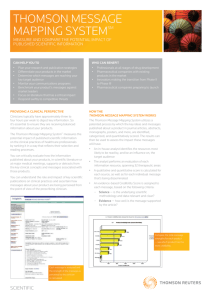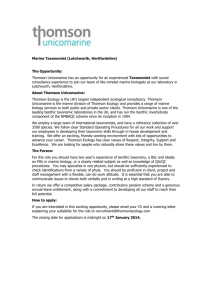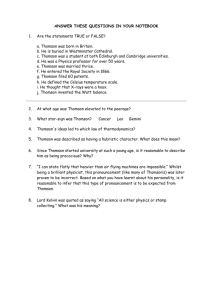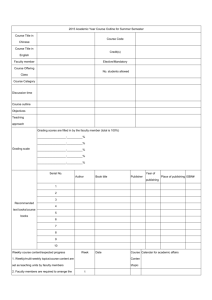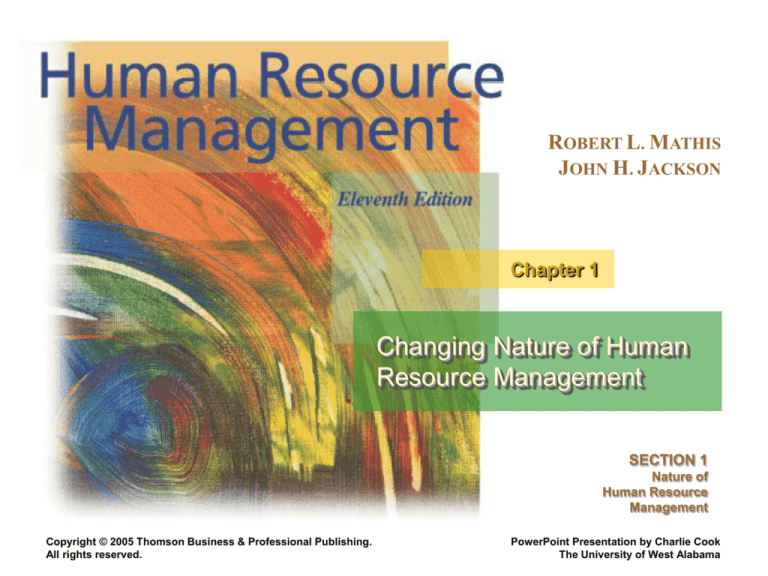
ROBERT L. MATHIS
JOHN H. JACKSON
Chapter 1
Changing Nature of Human
Resource Management
SECTION 1
Nature of
Human Resource
Management
Copyright © 2005 Thomson Business & Professional Publishing.
All rights reserved.
PowerPoint Presentation by Charlie Cook
The University of West Alabama
Learning Objectives
• After you have read this chapter, you should be
able to:
Define HR management and identify the seven
categories of HR activities.
Discuss three challenges facing HR today.
Describe how the major roles of HR management are
being transformed.
Identify the purposes and uses of HR technology.
Discuss why ethical issues affect HR management.
Explain the key competencies needed by HR
professionals and why certification is important.
Copyright © 2005 Thomson Business & Professional Publishing. All rights reserved.
1–2
Nature of Human Resource Management
• Human Resource (HR) Management
The design of formal systems in an organization to
ensure effective and efficient use of human talent to
accomplish organizational goals.
• Who Is an HR Manager?
In the course carrying out their duties, every operating
manager is, in essence, an HR manager.
HR specialists design processes and systems that
operating managers help implement.
Copyright © 2005 Thomson Business & Professional Publishing. All rights reserved.
1–3
HR
Management
Activities
Source: HR Department Benchmarks and Analysis Survey 2004
(Washington, DC: Bureau of National Affairs, 2004), 21. To purchase
this publication and find out more about other BNA HR solutions visit
http://hrcenter.bna.com or call 800-372-1033. Used with permission.
Copyright © 2005 Thomson Business & Professional Publishing. All rights reserved.
Figure 1–1
1–4
HR Activities
•
•
•
•
•
•
•
Strategic HR Management
Equal Employment Opportunity
Staffing
HR Development
Compensation and Benefits
Health, Safety, and Security
Employee and Labor Relations
Copyright © 2005 Thomson Business & Professional Publishing. All rights reserved.
1–5
Smaller Organizations and HR Management
Shortage of
Qualified
Workers
Compliance with
Government
Regulations
Issues of
Greatest
Concern
Increasing
Costs of
Benefits
Rising Taxes
Copyright © 2005 Thomson Business & Professional Publishing. All rights reserved.
1–6
Cooperation of HR with Operating Managers
• HR Unit
Develops legal, effective
interviewing techniques
Trains managers in
conducting selection
interviews
Conducts interviews and
testing
Sends top three applicants
to managers for final review
Checks references
Does final interviewing and
hiring for certain job
classifications
• Managers
Advise HR of job openings
Decide whether to do own
final interviewing
Receive interview training
from HR unit
Do final interviewing and
hiring where appropriate
Review reference
information
Provide feedback to HR unit
on hiring/rejection decisions
Copyright © 2005 Thomson Business & Professional Publishing. All rights reserved.
1–7
Who Handles Training and Development
Note: Length of bars represents prevalence of activity among all surveyed employers.
Source: HR Department Benchmarks and Analysis Survey 2004 (Washington, DC: Bureau of
National Affairs, 2004), 21. To purchase this publication and find out more about other BNA HR
solutions visit http://hrcenter.bna.com or call 800-372-1033. Used with permission.
Copyright © 2005 Thomson Business & Professional Publishing. All rights reserved.
Figure 1–2
1–8
Typical Division of HR Responsibilities: Training
Figure 1–3
Copyright © 2005 Thomson Business & Professional Publishing. All rights reserved.
1–9
Management of Human Capital
In Organizations
• Human Capital
The collective value of the capabilities, knowledge,
skills, life experiences, and motivation of an
organizational workforce.
Also known as intellectual capital.
How to measure the strategic value of human assets?
• Core Competency
A unique capability that creates high value and
differentiates an organization from its competition.
HR competencies: a source of competitive advantage.
Copyright © 2005 Thomson Business & Professional Publishing. All rights reserved.
1–10
HR Management Challenges
• Globalization of Business
Outsourcing and increased competition
The threat of terrorism
• Economic and Technological Changes
Occupational shifts from manufacturing and
agriculture to service industries and
telecommunications.
Pressures of global competition causing firms to
adapt by lowering costs and increasing productivity.
• Technological Shifts and the Internet
Growth of information technology.
Copyright © 2005 Thomson Business & Professional Publishing. All rights reserved.
1–11
Fastest Growing Jobs to 2010
Source: U.S. Bureau of Labor Statistics, www.bls.gov.
Copyright © 2005 Thomson Business & Professional Publishing. All rights reserved.
Figure 1–4
1–12
HR Management Challenges
• Workforce Availability and Quality Concerns
Inadequate supply of workers with needed skills for
“knowledge jobs”
Education of workers in basic skills
• Growth in Contingent Workforce
Increases in temporary workers, independent
contractors, leased employees, and part-timers
caused by:
Need for flexibility in staffing levels
Increased difficulty in firing regular employees.
Reduced legal liability from contract employees
Copyright © 2005 Thomson Business & Professional Publishing. All rights reserved.
1–13
HR Management Challenges
• Workforce Demographics and Diversity
Increasing Racial/Ethnic Diversity
More Women in the Workforce
Single-parent households
Dual-career couples
Domestic partners
Working mothers and family/childcare
Significantly Aging Workforce
Age discrimination
Copyright © 2005 Thomson Business & Professional Publishing. All rights reserved.
1–14
HR Management Challenges
• Organizational Cost Pressures and
Restructuring
Mergers and Acquisitions
“Right-sizing”—eliminating of layers of management,
closing facilities, merging with other organizations,
and outplacing workers
Intended results are flatter organizations, increases in
productivity, quality, service and lower costs.
Costs are “survivor mentality”, loss of employee loyalty, and
turnover of valuable employees.
HR managers must work toward ensuring cultural
compatibility in mergers.
Copyright © 2005 Thomson Business & Professional Publishing. All rights reserved.
1–15
HR Management Roles
• Administrative Role
Clerical and administrative support operations (e.g.,
payroll and benefits work)
Technology is transforming how HR services are delivered.
Outsourcing HR services to reduce HR staffing costs
• Operational and Employee Advocate Role
“Champion” for employee concerns
Employee crisis management
Responding to employee complaints
Copyright © 2005 Thomson Business & Professional Publishing. All rights reserved.
1–16
Changing Roles of HR Management
Note: Example percentages are based on various surveys.
Copyright © 2005 Thomson Business & Professional Publishing. All rights reserved.
Figure 1–5
1–17
Strategic Role for HR
• Strategic Role
“Contributing at the Table” to organizational results
HR becomes a strategic business partner by:
Focusing on developing HR programs that enhance
organizational performance.
Involving HR in strategic planning at the onset.
Participating in decision making on mergers, acquisitions,
and downsizing.
Redesigning organizations and work processes
Accounting and documenting the financial results of HR
activities.
Copyright © 2005 Thomson Business & Professional Publishing. All rights reserved.
1–18
Operational to Strategic Transformation of HR
Figure 1–6
Copyright © 2005 Thomson Business & Professional Publishing. All rights reserved.
1–19
New Approaches to HR Management
• Collaborative HR
The process of HR professionals from several
different organizations working jointly to address
shared business problems.
Firms benefit from the expertise of other firms, without having
the time and expense of developing some of their own HR
practices.
Copyright © 2005 Thomson Business & Professional Publishing. All rights reserved.
1–20
HR Technology
• Human Resource Management System (HRMS)
An integrated system providing information used by
HR management in decision making.
Purposes (Benefits) of HRMS
Administrative and operational efficiency in compiling HR
data
Availability of data for effective HR strategic planning
Uses of HRMS
Automation of payroll and benefit activities
EEO/affirmative action tracking
HR Workflow: increased access to HR information
– Employee self-service reduces HR costs.
Copyright © 2005 Thomson Business & Professional Publishing. All rights reserved.
1–21
Uses of an HRMS
• HRMS
Bulletin boards
What information will be available and what is information
needed?
Data access
To what uses will the information be put?
Employee self-service
Who will be allowed to access to what information?
Web-based services and access
Extended linkage
When, where, and how often will the information be needed?
Copyright © 2005 Thomson Business & Professional Publishing. All rights reserved.
1–22
Ethics and HR Management
• Firms with High Ethical Standards
Are more likely to reach strategic goals.
Are viewed more positively by stakeholders
Are better able to attract and retain human resources.
• Ethics and Global Differences
Different legal, political, and cultural factors in other
countries can lead to ethical conflicts for global
managers.
Foreign Corrupt Practices Act (FCPA)
Prohibits U.S. firms from engaging in bribery and other
practices in other countries.
Copyright © 2005 Thomson Business & Professional Publishing. All rights reserved.
1–23
HR’s Role in Organizational Ethics
• HR management plays a key role as the “keeper
and voice” of organizational ethics.
• What is Ethical Behavior?
What “ought” to be done.
Dimensions of decisions about ethical issues in
management:
Extended consequences
Multiple alternatives
Mixed outcomes
Uncertain consequences
Personal effects
Copyright © 2005 Thomson Business & Professional Publishing. All rights reserved.
1–24
Examples of Ethical Misconduct in HR Activities
Figure 1–7
Copyright © 2005 Thomson Business & Professional Publishing. All rights reserved.
1–25
HR’s Role in Organizational Ethics (cont’d)
• Responses to Ethical Situations
Are guided by values and personal behavior “codes”
that include:
Does
response meet all applicable laws, regulations, and
government codes?
Does response comply with all organizational standards of
ethical behavior?
Does response pass the test of professional standards for
ethical behavior?
Copyright © 2005 Thomson Business & Professional Publishing. All rights reserved.
1–26
Ethical Behavior and Organizational Culture
• Organizational Culture
The shared values and beliefs in an organization
Common forms of unethical conduct:
Lying to supervisors
Employee drug use or alcohol abuse
Falsification of records
• Fostering Ethical Behavior
A written code of ethics and standards of conduct
Training on ethical behavior for all employees
A means for employees to obtain ethical advice
Confidential reporting systems for ethical misconduct
Copyright © 2005 Thomson Business & Professional Publishing. All rights reserved.
1–27
HR Management Competencies
and Careers
• Important HR Competencies
Strategic contribution to organizational success
Business knowledge of organization and its strategies
Effective and effective delivery of HR services
Familiarity with HRMS technology
Personal credibility
Copyright © 2005 Thomson Business & Professional Publishing. All rights reserved.
1–28
HR Management as a Career Field
• HR Generalist
A person with responsibility for performing a variety of
HR activities.
• HR Specialist
A person with in-depth knowledge and expertise in a
limited area of HR.
Copyright © 2005 Thomson Business & Professional Publishing. All rights reserved.
1–29
HR Specialists
Source: HR Department Benchmarks and Analysis 2004 (Washington, DC: Bureau of National
Affairs, 2004), 119. To purchase this publication and find out more about other BNA HR
solutions visit http://hrcenter.bna.com or call 800-372-1033. Used with permission.
Copyright © 2005 Thomson Business & Professional Publishing. All rights reserved.
Figure 1–8
1–30
HR Certification
The Human Resource Certification Institute offers three types of
professional certifications for HR generalists.
Details on these certifications are available from the
Human Resources Certification Institute, www.hrci.org.
Figure 1–9
Copyright © 2005 Thomson Business & Professional Publishing. All rights reserved.
1–31
GPHR Certification
• Global Professional in Human Resources
(GPHR) certification subject areas:
Strategic international HR management
Organizational effectiveness and employee
development
Global staffing
International assignment management
Global compensation and benefits
International employee relations and regulations
Copyright © 2005 Thomson Business & Professional Publishing. All rights reserved.
1–32
Other HR Certifications
• Certified Compensation Professional (CCP), sponsored by the World at
Work Association
• Certified Employee Benefits Specialist (CEBS), sponsored by the
International Foundation of Employee Benefits Plans
• Certified Benefits Professional (CBP), sponsored by the WorldatWork
Association
• Certified Performance Technologist (CPT), co- sponsored by the American
Society for Training & Development and the International Society for
Performance Improvement
• Certified Safety Professional (CSP), sponsored by the Board of Certified
Safety Professionals
• Occupational Health and Safety Technologist (OHST), given by the
American Board of Industrial Hygiene and the Board of Certified Safety
Professionals
• Certified Professional Outsourcing, provided by New York University and
the Human Resource Outsourcing Association
Copyright © 2005 Thomson Business & Professional Publishing. All rights reserved.
1–33




